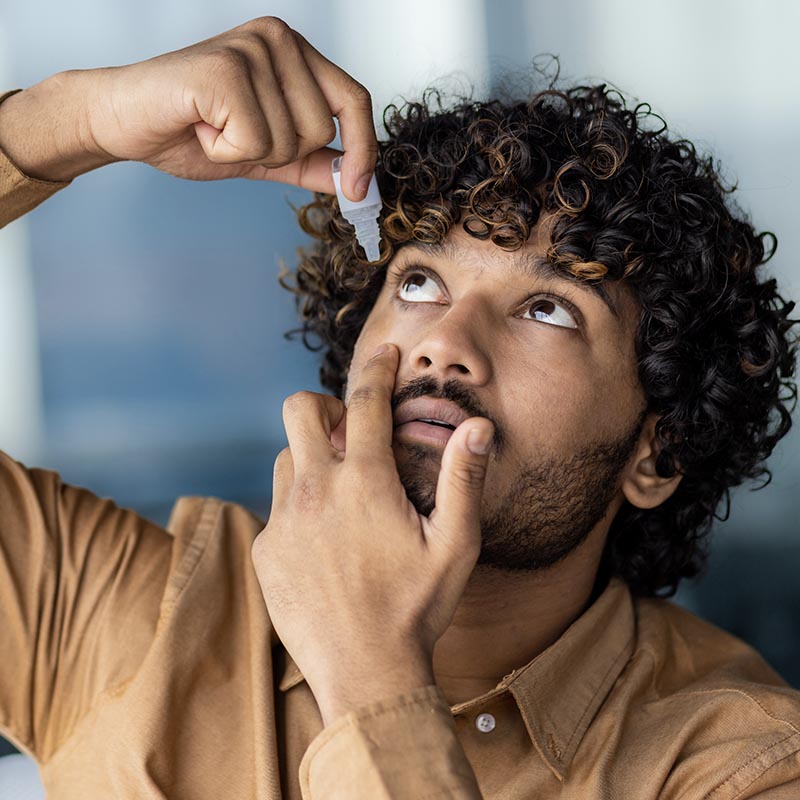Dry Eye Treatment
Relieve Discomfort. Restore Moisture. Reclaim Comfort.



Introduction to Dry Eye Treatment
Dry eye isn’t just a nuisance—it’s a chronic condition that can affect your comfort, vision, and quality of life. We offer the most advanced treatment options for dry eye syndrome at Rocky Mountain University Eye Institute, including custom therapies like serum tears and light-based treatments. Our team is here to help you find lasting relief and return to feeling like yourself again.
- Personalized treatment plans based on your symptoms and needs
- Advanced options, including OptiLIGHT IPL and autologous serum eye drops
- Relief from burning, irritation, blurry vision, and light sensitivity
- Serving patients in Provo, Lehi, Orem, Springville, and surrounding areas
What Causes Dry Eye and How We Treat It
Understanding the Root of the Problem
Dry eye syndrome can be caused by aging, hormone changes, medications, underlying health conditions, environmental factors, or prolonged screen use. Symptoms often include stinging, redness, blurred vision, and even excessive tearing. At RMU Eye Institute, we begin with a detailed exam to pinpoint the cause and tailor your treatment. Options range from over-the-counter relief to advanced therapies like IPL and personalized serum tears, depending on your needs.
Who Should Seek Dry Eye Treatment?
Is It Time to Get Help for Dry Eye?
If you experience any of the following symptoms, you may benefit from professional dry eye care:
-
Stinging or burning sensation in the eyes
-
Red, irritated eyes
-
Blurred vision or eye fatigue
-
Watery eyes caused by irritation
-
Sensitivity to light or gritty, scratchy feelings
Dry eye can become chronic if left untreated. Whether your symptoms are mild or severe, we’re here to help you find the right solution.
Advanced Treatment Options for Dry Eye
Next-Level Relief Starts Here
At RMU Eye Institute, we combine leading-edge care with compassion. Our most innovative treatments include:
OptiLIGHT IPL (Intense Pulsed Light)
Uses light pulses to treat inflammation and unclog the glands in your eyelids that help produce healthy tears. A non-invasive, in-office procedure with minimal downtime.
Dry Eye Serum Therapy (Autologous Serum Eye Drops)
Customized drops made from your own blood serum, rich in healing components your natural tears may lack. Especially helpful for patients with moderate to severe dry eye or autoimmune conditions.
Other Treatments Include:
-
Prescription or over-the-counter eye drops
-
Tear duct plugs to retain natural tears
-
Eyelid hygiene and inflammation control
-
Lifestyle guidance and home therapies
Each plan is customized and monitored closely to ensure long-term relief and improved comfort.
Frequently Asked Questions
What causes dry eye syndrome?
Dry eye can result from aging, hormonal changes, autoimmune conditions, screen use, certain medications, or environmental factors like wind and dry air. It often occurs when your eyes don’t produce enough tears or the tears evaporate too quickly.
What is OptiLIGHT IPL treatment for dry eye?
OptiLIGHT IPL is an advanced light therapy that targets the root cause of dry eye—memibomian gland dysfunction. It uses controlled light pulses to reduce inflammation and unclog the oil glands along your eyelids, helping your tears stay in your eyes longer.
What are serum eye drops, and how do they work?
Serum eye drops are made from your blood serum and are rich in nutrients and growth factors that support healing. They’re especially effective for patients with severe dry eye or those who haven’t responded to traditional drops.
Are dry eye treatments safe?
Yes! Treatments like IPL and serum therapy are safe and FDA-approved when administered by qualified professionals. We tailor your care plan and monitor your progress to ensure comfort and effectiveness.
Can dry eye be cured?
Dry eye is usually manageable and not curable, but symptoms can be significantly reduced or even eliminated with the right treatment. Our goal is to improve your tear quality and reduce inflammation to keep your eyes comfortable long term.
How do I know which treatment is right for me?
We start with a comprehensive dry eye evaluation to identify the underlying cause. Based on your symptoms, tear composition, and lifestyle, we’ll recommend a personalized treatment plan, including drops, IPL, or serum therapy.

